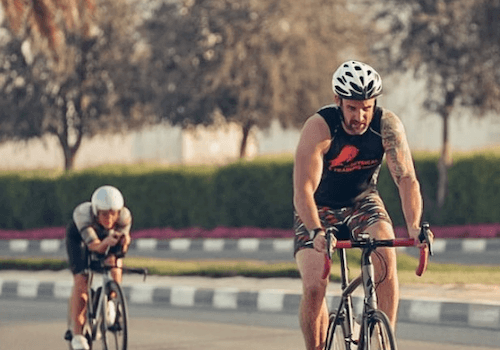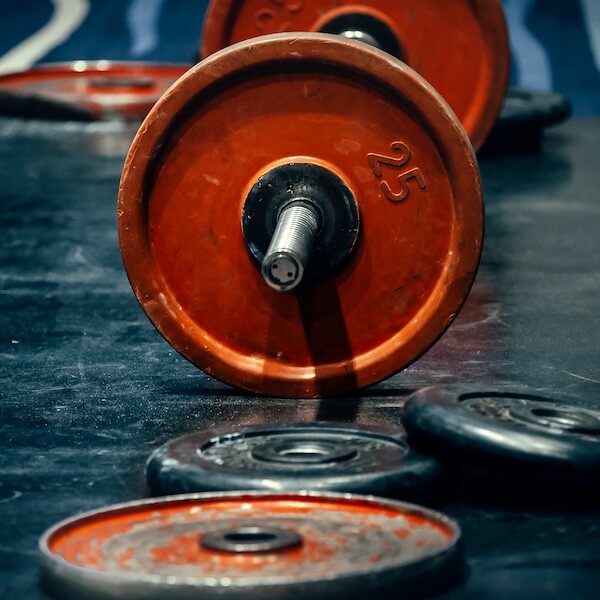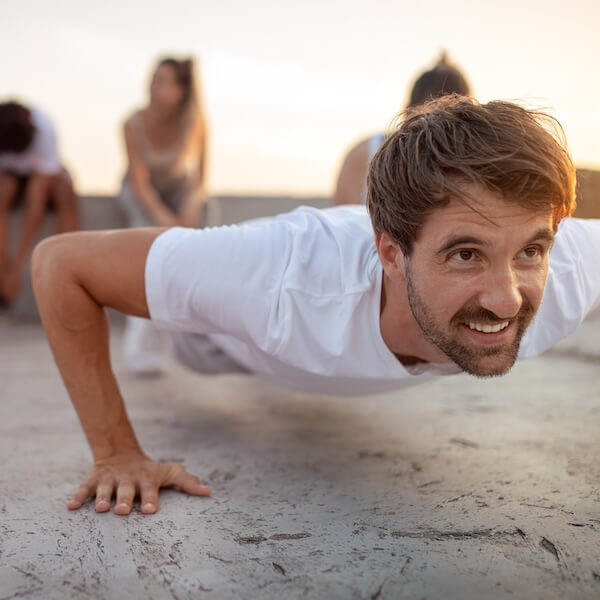Top Exercises for Cycling

Strength training is a critical component for any cyclist looking to enhance their riding performance and minimize the risk of injuries.
Integrating specific exercises into a cyclist's routine not only boosts pedal efficiency but also supports overall endurance on the bike.
FURTHER READING AND RESEARCH
This blog post delves into the various exercises tailored for cyclists, ranging from core stability to upper body strength, highlighting how these workouts complement cycling activities and contribute to a more robust and injury-resistant physique.
By adopting a structured training regimen that includes these exercises, cyclists can look forward to improved performance and a healthier, more balanced body that is well-prepared to handle the demands of both casual riding and competitive racing.
Understanding the Role of Strength Training in Cycling
The Importance of Strength Training for Cyclists
Strength training is not just supplementary; it's fundamental for cyclists aiming to improve pedal stroke efficiency and reduce the risk of injuries.
Strength training for cyclists focuses on building the muscle groups that are critical for power and endurance while riding.
Engaging in strength training exercises helps to enhance the overall force that a cyclist can exert on the pedals, leading to more effective rides and better handling of the bike during longer or more challenging courses.
Importantly, such training helps to prevent injury by fortifying the body against the strains of repetitive motions and the impact of the road.


How Strength Training Complements Cycling
Incorporating strength training into a cyclist’s routine improves not just muscle power but overall body balance and stability.
Exercises tailored for cyclists help ensure that the upper body, lower body, and core strength are all engaged, creating a more unified and efficient movement during cycling.
This synergy is critical because a well-conditioned body can maintain a straight line from the shoulder width to the pedals without unnecessary wobbling or energy waste, enhancing overall cycling fitness.
For example, maintaining a feet shoulder width position during bodyweight exercises like push-ups and pull-ups ensures stability and engages the core, essential for power transfer and injury prevention.
Similarly, performing strength training exercises like squats and lunges from a starting position with feet hip width apart helps to develop leg and glute muscles that are pivotal during every pedal stroke.
Moreover, focusing on one-leg exercises, where knees are bent to mimic the cycling motion, can improve the single-leg strength required for efficient pedaling, especially in scenarios where maintaining a consistent power output is necessary, such as in hill climbs or sprints.
These exercises ensure that cyclists can continue to perform at their best, making strength training for cyclists a non-negotiable part of their training regimen.
Core Exercises for Cyclists
Introduction to Core Stability for Cycling
A strong core is essential for optimal cycling performance. Core stability enhances balance and energy transfer, allowing cyclists to maintain good form and posture throughout their ride.
Keeping the core tight is fundamental during cycling as it supports the upper body and minimizes unnecessary movements, thus conserving energy that can be utilized for pedaling.
Key Core Exercises
- Planks for Core Tightening
- Plank Position: Start by lying face down. Raise yourself up onto your elbows and toes, ensuring your body forms a straight line from head to heels. Keep your feet flat and core tight.
- Importance: This exercise strengthens the entire core, which helps cyclists maintain good posture and stability in the saddle.
- Single Leg Glute Bridges for Lower Body and Core Strength
- Execution: Lie on your back with knees bent and feet flat on the floor. Extend the right leg straight out. Push through the heel of the left foot to lift your hips off the ground, forming a bridge. Hold the top position briefly, then slowly lower down.
- Focus: Targets the glutes and hamstrings on the active leg, while the elevated leg intensifies the engagement of the core and lower back. This exercise helps to correct muscle imbalances and is ideal for weight training as it builds bone density and body composition.
- Explosive Movement with Single Leg Squats
- Setup: Begin in a standing position with one leg slightly raised in front. Lower into a squat on the supporting leg, keeping the knee of the other leg bent. Ensure to hinge forward slightly to keep balance.
- Benefits: These exercises for cyclists are crucial for developing leg strength, particularly the quads and glutes. The single-leg focus mimics the pedal stroke, enhancing leg muscles and promoting bone density through weight lifting.
Each exercise should be performed with attention to good form to maximize benefits and minimize the risk of injury.
Engage a conditioning coach or certified personal trainer to ensure proper technique and to adjust the higher rep ranges for endurance or lower reps for strength, based on your training goals.
Simple exercises like these not only enhance physical conditioning but also play a significant role in injury prevention and ensuring longevity in the sport of cycling.
Lower Body Strength Training
Building Leg Strength for Powerful Pedaling
For cyclists, leg strength is not just about power; it's about endurance. Exercises that focus on the lower body are crucial for developing the necessary muscle mass and stamina that benefit long rides and challenging terrains.
- Squats with External Weight
- Starting Position: Stand with feet shoulder width apart, holding a heavy weight like a barbell or dumbbells.
- Execution: Lower your body by bending the knees and keeping the back straight, as if sitting back into a chair. Ensure your knees do not go past your toes. Push back up to the starting position.
- Focus: This exercise increases muscle mass and strengthens the entire lower body, including the hip flexors, which are vital for effective pedaling.
- Single Leg Deadlifts for Balance and Strength
- Setup: Stand on one leg, holding a resistance band or free weight in front of you.
- Execution: Bend forward at the hip, extending the free leg behind you for balance. Lower the weight slowly, keeping the back straight and the hip flexors tight. Return to the starting position.
- Benefits: Single leg exercises like this not only challenge your balance but also strengthen the leg muscles symmetrically, reducing the risk of knee pain and muscle imbalances.
Specific Exercises and Techniques
- Pull Ups for Overall Strength
- Starting Position: Hang from a pull-up bar with hands slightly wider than shoulder width apart.
- Execution: Pull your body up until the chin is over the bar, then slowly lower back to the starting position.
- Importance: While primarily an upper body workout, pull ups also engage the core and lower body if performed with the correct form, making them a great addition to a strength workouts routine.
- Low-Intensity Push Ups for Recovery Days
- Setup: Get into a plank position with hands under your shoulders and feet hip width apart.
- Execution: Lower your chest towards the ground, keeping the elbows close to your body, then push back up.
- Role: On base training days or recovery periods, doing low intensity push-ups helps maintain muscle mass without overstraining. This approach is essential in a balanced training routine.
Incorporating these exercises into a strength focus regimen enhances not just cycling performance but also general fitness and entire body health.
Whether using own body weight or external weights, each exercise should be performed with precision to prevent injuries and ensure optimal gains.
A certified personal trainer in Dubai can provide guidance on adjusting the intensity and volume of these exercises to fit into an overall training plan, tailored specifically to the needs of cyclists.
Upper Body and Flexibility Routines
Upper Body Strength for Cyclists
While the legs do much of the work in cycling, upper body strength plays a crucial role in overall performance and endurance.
Strengthening the upper body helps cyclists maintain good posture and control, especially during long rides or when climbing hills.
- Push-Ups for Core and Upper Body Strength
- Starting Position: Place your hands on the ground shoulder width apart, extend your legs back so that you are in a straight line from head to heels.
- Execution: Lower your body until your chest nearly touches the ground, then push up back to the starting position. Keep your core tight throughout the movement to stabilize your entire body.
- Benefits: Push-ups enhance upper body strength, including the shoulders, arms, and chest, while also engaging the core, which is vital for cycling posture.


2. Pull-Ups for Comprehensive Upper Body Conditioning
- Setup: Grip a pull-up bar with hands wider than shoulder width.
- Execution: Pull your body up until your chin is over the bar, then slowly lower back down. This movement targets the back, shoulders, and arms.
- Importance: Pull-ups are a powerful weight training exercise for building upper body and core strength, essential for controlling the bike and reducing injury risk.
Enhancing Flexibility and Recovery
Flexibility exercises and proper recovery routines are essential to reduce the risk of knee pain and other common cycling injuries.
Incorporating stretches and light body weight exercises can enhance muscle elasticity and promote recovery.
- Dynamic Stretches for Hip Flexors and Legs
- Exercises: High knees, leg swings, and lunges.
- Focus: These movements help warm up the hip flexors and legs, preparing them for a ride and reducing the chance of strain or injury.
- Cool-Down Routines Involving Light Yoga or Stretching
- Activities: Gentle yoga poses or stretches that target the entire body.
- Benefits: These activities help in muscle mass maintenance and flexibility, crucial for cyclists who often experience stiffness after long periods of pedaling.
By integrating these strength workouts and flexibility routines into their training routine, cyclists can improve their body composition, enhance performance, and lower the chances of sustaining injuries.
Each session should be tailored to the individual’s needs, considering any previous injuries or specific areas of weakness, and should incorporate single leg exercises and heavy weight training as needed for balance and strength.
Regular consultation with a certified personal trainer or conditioning coach can ensure that the exercises are performed correctly and effectively, maximizing the benefits for cycling and overall health.
Preventing Common Cycling Injuries
Common Cycling Injuries and How to Avoid Them
Cycling, while beneficial for cardiovascular health and fitness, can expose cyclists to specific injuries, especially when proper care is not taken. Knee pain, muscle imbalances, and injuries related to repetitive stress are common. Understanding these risks and how to mitigate them is crucial for every cyclist.
- Knee Pain: Prevention Through Proper Alignment and Strength
- Causes: Often results from overuse, improper saddle height, or poor leg alignment during cycling.
- Prevention: Ensure the bike fit is correct; knee should be slightly bent at the lowest pedal position. Strengthening the muscles around the knee through single leg exercises and weight training can also help support the joint and correct muscle imbalances.
- Lower Back Pain: Minimizing Risk with Core Strengthening
- Contributors: Long periods in a static riding position can strain the lower back, particularly if core strength is lacking.
- Strategies: Incorporate core stability exercises like planks and bridges into your routine. These strengthen the midsection, supporting the spine and reducing strain.
- Muscle Strains and Imbalances: Balanced Training Regimens
- Issue: Imbalances can occur when certain muscles are overused while others are neglected.
- Solution: Engage in a training routine that includes both upper body and lower body strength workouts. External weights and body weight exercises should be used to ensure all muscle groups are adequately strengthened, maintaining good posture and reducing injury risk.
Tailoring Your Training Plan
Creating a balanced training schedule is essential not only for performance enhancement but also for injury prevention. Collaborating with a USA cycling certified coach or a certified personal trainer can provide you with a personalized training plan that addresses your specific needs and goals.
- Personalized Training: Your coach can help design a regimen that focuses on strengthening weak areas, improving flexibility, and incrementally increasing the intensity of workouts to match your evolving fitness level.
- Consistency and Progression: Regularly updating your training activities to keep them challenging yet safe is crucial. It’s important to progress at a pace that your body can handle without overtraining.
Incorporating regular strength focus sessions, ensuring muscle mass is maintained and balanced, and addressing any single leg weaknesses are all parts of a holistic approach to cycling training that can help prevent injury and enhance overall performance.
CONCLUSION
Successfully integrating targeted exercises into your cycling regimen is not just about enhancing performance—it's also about safeguarding your body against potential injuries and ensuring a sustainable and enjoyable cycling experience.

By adopting a comprehensive approach that includes strength training, flexibility exercises, and injury prevention strategies, cyclists can look forward to improved health and better performance.
At The Physical Training Company, our team of expert trainers and rehabilitation specialists are here to guide you through personalized training plans designed to meet your specific needs.
Whether you’re looking to boost your pedal stroke efficiency, recover from an injury, or enhance your overall cycling fitness, we are here to support your journey. Engage with our professionals to harness the full benefits of living an active, healthy lifestyle through cycling.

